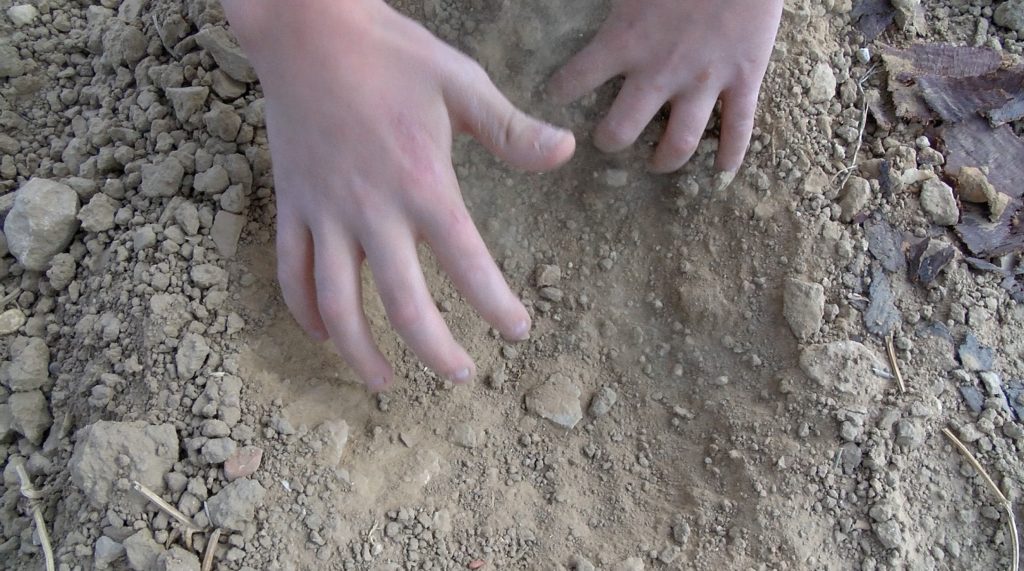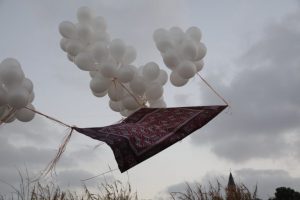The exhibition at the Beeri gallery connects Shimon Pinto, who spent his childhood and adolescence in Arad with a religious family of Moroccan descent, to the place’s existence. It connects him to his early memories as a child and teenager, the meeting points between then and now, the questions of a child encountering death for the first time, and the 13-year-old outsider who was educated in Kibbutz Beeri. After many years, returning to Beeri as an adult artist was somewhat exciting and intriguing. It triggered the formation of different works and the creation of a layered and meaningful exhibition. The initial decision that underlies the exhibition is to come to the place, stay in it, experience it, and create using the materials available in the area. A memory imprinted on him from the time he spent in Beeri as a teenager withdraws into the campfire evenings held behind the sheds by a group of adventurous, unaccompanied teenagers who came to be educated on the kibbutz. The campfire is the ceremonial and pagan tribal campfire, the gathering around it, the friendships forged; the burnt embers remain at the end as a testimony to the nocturnal experience. At the exhibition in Beeri, Shimon Pinto decides to burn trees and use them to draw on the gallery walls. Coal is also a substance – a body burnt to ashes, which leaves its traces on the white sheet of paper. Pinto creates out of the nothingness, the fire, and cessation of the burnt tree.
The question “whither?” hovers over the exhibition (Where? In what place?). The answers are in the question, in the artist’s endless search for it, in the contrasting of worlds and opposite concepts like heaven and earth, innocence and intellect, and the question of redemption. The artist’s pictorial action stems from life’s materials, the surviving logic inherent in the physical and the mental spaces. In another memory fragment woven into the exhibition – Pinto, a five-year-old boy, arrives with his mother at the temporary IDF casualty cemetery near the kibbutz gate, immediately after the Yom Kippur War, to meet his uncle in the mounds field. His mother cries, and he asks her why she’s crying and where the uncle they came to meet is. She answers that he’s in the ground, and the little boy’s hands try to extricate him from the ground, but death is final and inconceivable.
At the center of the white gallery space, there’s a structure surrounded by a construction made of building netting to which thousands of white plastic bags are attached. The structure is reminiscent of a sacred prayer space, a holy Jewish burial place, wrapped in a bride’s dress or swan feathers. The work with simple plastic bags from the world of consumerism is transformed onto the level of holiness and purity, a place for communion, prayer, and wish expression. Opposite the white structure’s wall is a large, weighty door, a black opening constituting an entrance into a world of chaos, an unknown abyss, standing on the threshold between the worlds. This place challenges Pinto. Drawing directly on the large paper using the charcoal pieces from the bonfire leaves traces of the artist’s broad hand movement, traces of engraving, a mesmerizing array of lines and textures, cracks and stains, like wounds in the paper. Angels are painted on both sides of the structure, the forces of life and death. The bull on the left represents audacity and inclination, the angel represents the power of good. Both represent the question and the answer, the contrast, and the opposites. Landscapes constituting the virginal, primal space, in which no human foot has trodden, are painted on the surrounding walls. The raw place that produces the reality that is an abstract every-place and nowhere and at the same time, a concrete place – the Negev area, the mountain ranges around the city of Arad, the landscape of the artist’s childhood.
A blackened, burnt cabinet, which simulates an altar, stands in the niche, a transitional object whose function is to contain and hold the fork positioned on it upside down. According to an ancient belief originating in the Moroccan Jewry, it’s a wish expressing ritual; if the fork falls, the wish will come true. As we surround the structure, an opening to the screening room is revealed. In the space’s center, there’s a bed with a pillow and a white sheet that brings shrouds or a tomb to mind. The video “Maktub” is projected above it. It shows a boy’s hands digging in the ground. A movement of searching, burrowing, extracting land is accompanied by incessant panting. Opposite the video is the image of the dead tree standing motionless as the clouds move behind it. The child’s hands are looking for answers to the world of life and death, searching for an answer that will satisfy them, an answer that is not attainable.
Throughout his work, and in this exhibition, Shimon Pinto takes the innocent viewpoint of the child who wonders about the world and its customs, looking at them through fragments and shards of memory and forgetfulness, and through them, deals with philosophical questions of faith, and redemption.







